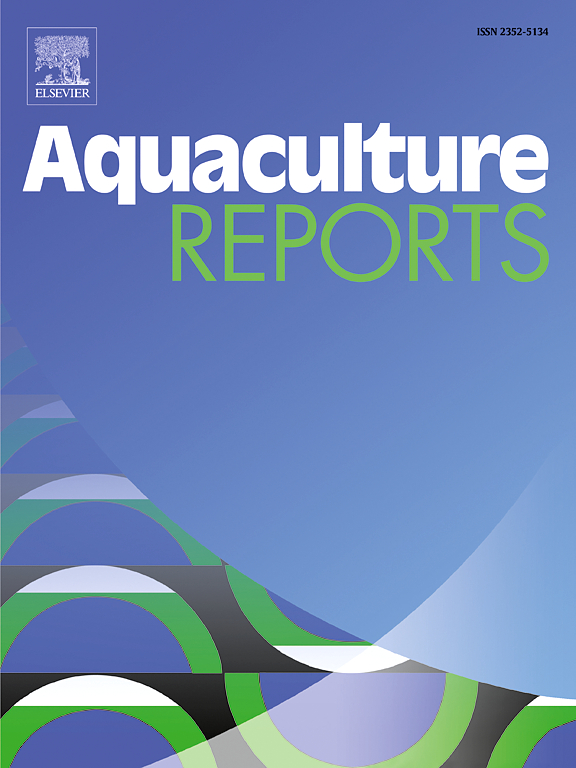unicucus耐碱性性状遗传参数的估计
IF 3.7
2区 农林科学
Q1 FISHERIES
引用次数: 0
摘要
unicinctus echiura worm具有很高的营养和药用价值,是我国特色的水生种质资源。然而,过度捕捞和社会需求使得这一市场缺口难以填补。由于环境条件恶劣,中国大面积的盐碱水仍然是一个巨大的未开发资源。为解决中国耐碱种质资源匮乏的问题,从秦皇岛野生种群中分离出15个全同胞家系,进行了系统的碱胁迫试验。结果表明,该菌株72 h LC50为85.59 mM。我们首次估算了unicinctus耐碱性状的遗传参数,计算出耐碱性状的遗传力为0.14 ± 0.06 (P <; 0.05),属于低水平遗传力,可以通过群体杂交、分子育种和家族选择育种进行改良。耐碱性性状与体重的遗传相关系数和表型相关系数分别为0.97 ± 0.02和0.82 ± 0.02 (P <; 0.01),Pearson相关系数为0.49 (P <; 0.01)。结果表明,耐碱性与体重呈显著相关,可通过体重间接选择耐碱性。本研究结果为选育耐碱优品种提供了有价值的见解,对促进盐碱水资源的利用具有重要价值。本文章由计算机程序翻译,如有差异,请以英文原文为准。
Estimation of genetic parameters for the alkalinity tolerance trait in Urechis unicinctus
The echiura worm Urechis unicinctus has high nutritional and medicinal values and has been identified as a Chinese featured aquatic germplasm resource. However, overfishing and social demand have made it difficult to fill this market gap. The vast area of saline-alkali water in China remains a huge unexploited resource owing to its harsh environmental conditions. To address the scarcity of alkali-tolerant germplasm resources of U. unicinctus in China, we established 15 full-sib families derived from wild Qinhuangdao populations for systematic alkali stress experiments. The 72-h LC50 of U. unicinctus was determined to be 85.59 mM. We estimated the genetic parameters of the alkalinity tolerance trait in U. unicinctus for the first time and calculated the heritability of the alkalinity tolerance trait as 0.14 ± 0.06 (P < 0.05), which belongs to a low level of heritability, indicating that it can be improved by population hybridization, molecular breeding, and family selection breeding. In addition, the genetic and phenotypic correlation coefficients between the alkalinity tolerance trait and body weight were 0.97 ± 0.02 and 0.82 ± 0.02 (P < 0.01), respectively, with a Pearson correlation coefficient of 0.49 (P < 0.01). These results indicate that alkali tolerance is significantly correlated with body weight and that alkali tolerance can be selected indirectly through body weight. The results of this study provide valuable insights for the selection breeding of superior varieties with alkali tolerance in U. unicinctus and have important value in promoting the utilization of saline-alkali water resources.
求助全文
通过发布文献求助,成功后即可免费获取论文全文。
去求助
来源期刊

Aquaculture Reports
Agricultural and Biological Sciences-Animal Science and Zoology
CiteScore
5.90
自引率
8.10%
发文量
469
审稿时长
77 days
期刊介绍:
Aquaculture Reports will publish original research papers and reviews documenting outstanding science with a regional context and focus, answering the need for high quality information on novel species, systems and regions in emerging areas of aquaculture research and development, such as integrated multi-trophic aquaculture, urban aquaculture, ornamental, unfed aquaculture, offshore aquaculture and others. Papers having industry research as priority and encompassing product development research or current industry practice are encouraged.
 求助内容:
求助内容: 应助结果提醒方式:
应助结果提醒方式:


